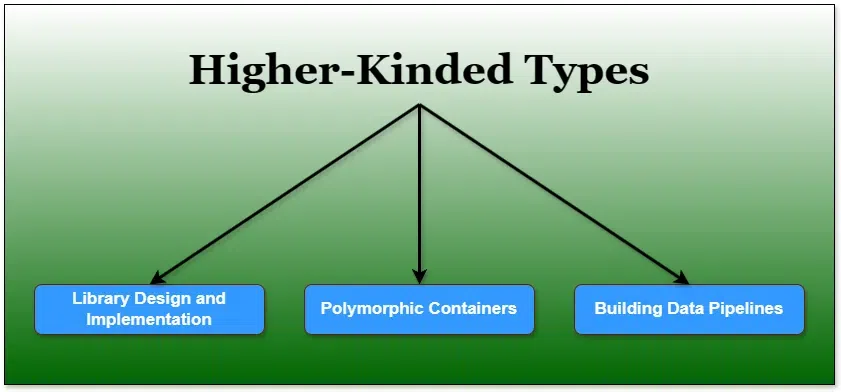This article focuses on discussing Higher-Kinded types in Scala.
What is the Higher-Kinded Type?
A higher-kinded type is a type that can stand for other types, which themselves stand for more types. It's a way to talk about types that are built from other types. They let us write code that can handle many different kinds of things. You could also think of them as types that have their building blocks.
Note:
Higher-kinded types made their debut in Scala 2.5.

Higher-Kinded Types in Scalaas
Implementing Higher-Kinded Types in Scala
Starting with Scala 2.5, there's a nifty feature called higher-kinded types.
- These types allow us to create a flexible 'Collection' interface.
- Think of this interface as a toolbox that can work with various types of containers like lists, optionals, and arrays. When we use 'F[]', it means we're talking about any type of container.
- It's like saying 'F' can be a list, set, or any other container. how it works:
Example
1. Create a collection seqCollection that behaves like a sequence and provides operations:
var seqCollection = new Collection[Seq] {
override def wrap[A](a: A): Seq[A] = Seq(a)
override def first[B](b: Seq[B]): B = b.head
}
assert(seqCollection.wrap("Some values") == Seq("Some values"))
assert(seqCollection.first(Seq("Some values")) == "Some values")
So, with higher-kinded types, we've created a versatile 'Collection' that can work with any container type.
2. Define a collection seqCollection that emulates a sequence and implements operations:
var seqCollection = new Collection[Seq] {
override def wrap[A](a: A): Seq[A] = Seq(a)
override def first[B](b: Seq[B]): B = b.head
}
assertEquals(seqCollection.wrap("Some values"), Seq("Some values"))
assertEquals(seqCollection.first(Seq("Some values")), "Some values")
So, with higher-kinded types, we have created a 'Collection' that can work with any type of container."
Higher-Kinded Types Use Cases
Higher-kinded types are like tools that help us organize and simplify our code. Let's look at how we use them in different situations:
1. Library Design and Implementation
Imagine you're building a library for others to use. Higher-kinded types let you give users more flexibility while avoiding repeating yourself. For instance, in Scala, the Scala project uses them to add functional programming features to the language.
2. Polymorphic Containers
Think of a box that can hold anything. Higher-kinded types help us create these kinds of boxes without needing a new one for each type of thing. This way, we can have a container that works for any type of item.
3. Building Data Pipelines
Consider a scenario where we're working with various types of data, performing tasks like reading, transforming, and saving it. Higher-kinded types shine here. Take, for instance, a task like transforming and saving data to a database. We can design a flexible framework that adapts to any data type.
Below is the Scala code for working with different types of collections:
def transform_and_save(data, collection):
// Imagine some code here that transforms and saves the data
pass
// We can use our function with any type of collection
list_data = ["data 1", "data 2"]
transform_and_save("data 3", list_data)
tuple_data = (1, 2)
transform_and_save(3, tuple_data)
Output:

In simpler terms, higher-kinded types are like versatile tools that help us write adaptable code. Whether we're crafting libraries, creating containers, or handling data, they streamline our work by minimizing repetitive code.
Conclusion
In this guide, we have explored higher-kinded types. We began by explaining what they are and why they are valuable. Then, we had divided into how they function specifically in Scala and explored practical scenarios where they prove beneficial. Higher-kinded types empower developers to write more flexible and reusable code.
Frequently Asked Questions on Higher-Kinded Types in Scala
What are higher-kinded types in Scala?
Higher-kinded types in Scala are types that work with other types, allowing for more flexibility and abstraction in code.
How do higher-kinded types differ from regular types?
Regular types in Scala represent specific data structures, while higher-kinded types abstract over type constructors, enabling more versatile and flexible code.
Why are higher-kinded types useful?
Higher-kinded types enable developers to write generic algorithms that can handle a variety of data structures, reducing redundancy and increasing code reusability.